A fruit is the edible, and more or less juicy, product of a tree or plant and consist of the matured ovary including its seeds and adjacent parts. Usually fruits are sweet, with a wide range of flavours, colours and textures.
Composition
Fruits are very poor source of protein and fat. Avocado is the exception containing 28% fat. Fruits contain high amount of moisture hence they are highly perishable. They are also good source of fibre. Fruits are not very good sources of calories. Fruits like bananas give fairly good amount of calories. Ripe fruit contains a higher percentage of sugar than unripe fruit does and the sugar is chief in the form of sucrose, fructose and glucose. Generally fruits are poor source of iron, Mangoes are excellent source of carotenes. Oranges are fairly good source of beta carotene. Guavas are the best source of vitamin C. Citrus fruits are good source of vitamin C. Cashew fruits are inexpensive and rich in vitamin C, although there is variation of vitamin content from fruit to fruit most fruits in the raw state contain some ascorbic acid. If fruits are bruised, peeled, cooked or exposed to air, large amounts of the vitamin may be oxidized. Apples are not only expensive; they contribute little to the nutritive value. They give fibre to the diet.
Value added products from fruits
Juice, RTS, Nectar, Squash, cordial, jam, preserve, toffee, Amchur, pickle, chutney, canned product, fruit powder, concentrate, jelly, cheese, toffee, vinegar, syrup, candy, wine, dried product, marmalade, cider, pickle.
Fruit beverages
Fruit beverages are easily digestible, highly refreshing, thirst quenching, appetizing and nutritionally far superior to many synthetic and aerated drinks. They can be classified into unfermented and fermented beverages.
Unfermented beverages
Fruit juices which do not undergo alcoholic fermentation are termed as unfermented beverages. They include natural and sweetened juices, RTS, nectar, cordial, squash, crush, syrup, fruit juice concentrate and fruit juice powder. Barley waters and carbonated beverages are also included in this group.
I. FRUIT BEVERAGE
Top
A. SQUASH
This is a type of fruit beverage containing at least 25 per cent fruit juice or pulp and 40 to 50 per cent total soluble solids, commercially. It also contains about 1.0per cent acid and 350 ppm sulphur dioxide or 600 ppm sodium benzoate. It is diluted before serving.
Mango, orange and pineapple are used for making squash commercially. It can also be prepared from lemon, bael, papaya, etc. using potassium metabisulphite (KMS) as preservative or from jamun, passion-fruit, peach, plum, raspberry, strawberry, grapefruit, etc. with sodium benzoate as preservative.
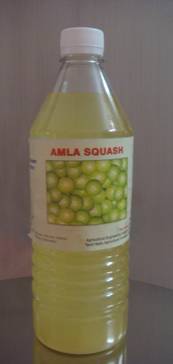 FLOWCHART FOR PROCESSING OF SQUASH FLOWCHART FOR PROCESSING OF SQUASH

B. READY-TO-SERVE (RTS)
This is a type of fruit beverage which contains at least 10 per cent fruit juice and 10 per cent total soluble solids besides about 0.3 per cent acid. It is not diluted before serving, hence it is known as ready-to-serve (RTS).
Flow-sheet for processing of RTS beverages

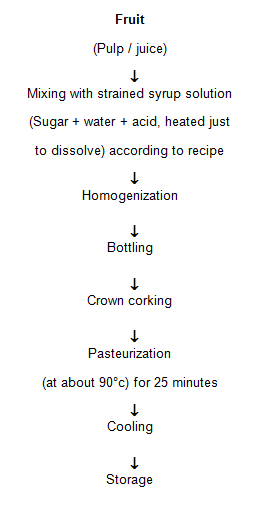
C. CORDIAL
It is a sparkling, clear, sweetened fruit juice from which pulp and other insoluble substances have been completely removed. It contains at least 25 per cent juice and 30 per cent TSS. It also contains about 1.5 per cent acid and 350 ppm of sulphur dioxide. This is very suitable for blending with wines. Lime and lemon are suitable for making cordial.
FLOWCHART FOR PROCESSING OF CORDIAL

D. NECTAR
This type of fruit beverage contains at least 20 per cent fruit juice / pulp and 15 per cent total soluble solids and also about 0.3 per cent acid. It is not diluted before serving.
| S. No. |
Fruit |
Juice / Pulp (%) |
Quantity of water required (litre) |
| 1. |
Mango |
20 |
Quantity of finished product (litre) – Quantity of (juice (litre) + sugar (kg) + acid (kg) used |
| 2. |
Papaya |
20 |
| 3. |
Guava |
20 |
| 4. |
Bael |
20 |
| 5. |
Jamun |
20 |
| 6. |
Aonla (blend) |
Aonla pulp 20
Lime juice 2
Ginger juice 1 |
For preparing the above beverages, the total soluble solids and total acid present in the pulp/juice are first determined and then the requisite amounts of sugar and citric acid dissolved in water are added for adjustment of TSS and acidity.
Fermented beverages
Fruit juices which have undergone alcoholic fermentation by yeasts include wine, champaigne, port, sherry, tokay, muscat, perry, orange wine, berry wine, nira and cider.
FLOWCHART FOR PROCESSING OF WINE
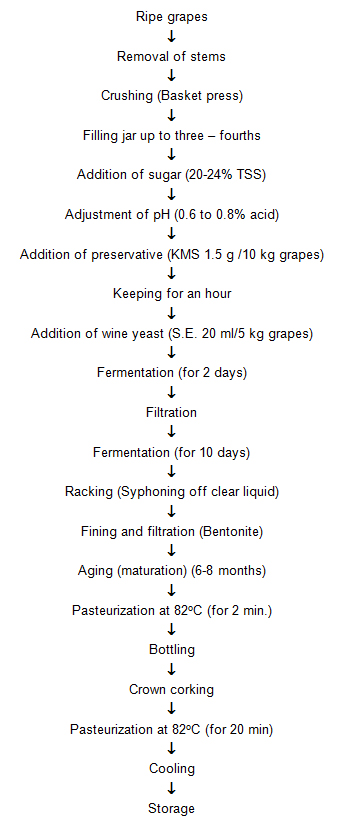
II. JAM, JELLY, MARMALADE
Top
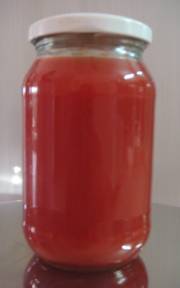 A. JAM A. JAM
Jam is a product made by boiling fruit pulp with sufficient amount of sugar to a reasonably thick consistency, firm enough to hold the fruit tissues in position. Apple, pear, sapota (chiku), peach, papaya, karonda, carrot, plum, straw-berry, raspberry, mango, tomato, grapes and muskmelon are used for preparation of jams. It can be prepared from one kind of fruit or from two or more kinds.
FLOWCHART FOR PROCESSING OF JAM

B. JELLY
A jelly is a semi-solid product prepared by boiling a clear, strained solution of pectin-containing fruit extract, free from pulp, after the addition of sugar and acid. A perfect jelly should be transparent, well-set, but not too stiff, and should have the original flavour of the fruit. It should be of attractive colour and keep its shape when removed from the mould. It should be firm enough to retain a sharp edge but tender enough to quiver when pressed.
Guava, sour apple, plum, karonda, wood apple, loquat, papaya and goose-berry are generally used for preparation of jelly. Apricot, pineapple, strawberry, raspberry, etc. can be used but only after addition of pectin powder, because these fruits have low pectin content.
FLOWCHART FOR PROCESSING OF JELLY
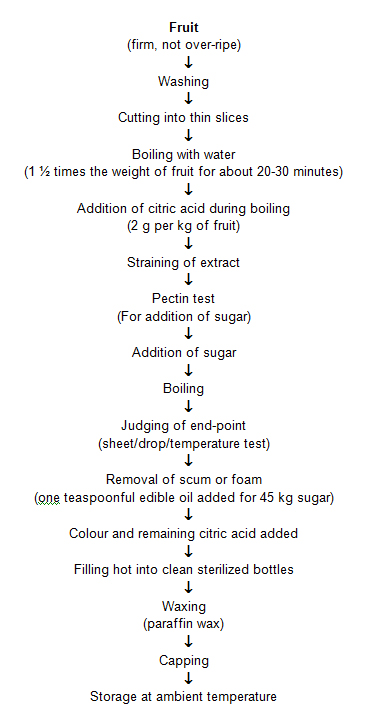
C. MARMALADE
This is a fruit jelly in which slices of the fruit or its peel are suspended. The term is generally used for products made from citrus fruits like oranges and lemons in which shredded peel is used as the suspended material. Citrus marmalades are classified into (i) jelly marmalade, and (ii) jam marmalade.
1. Jelly marmalade
The following combinations give good quality of jelly marmalade:
i. Sweet orange (Malta) and khatta or sour orange (Citrus aurantium) in the ratio of 2:1 by weight. Shreds of Malta orange peel are used.
ii. Mandarin orange and khatta in the ratio of 2:1 by weight. Shreds of Malta orange peel are used.
iii. Sweet orange (Malta) and galgal (Citrus limonia) in the ratio of 2:1 by weight. Shreds of Malta orange peel are used.
2. Jam marmalade
The method of preparation is practically the same as that for jelly marmalade. In this case the pectin extract of fruit is not clarified and the whole pulp is used. Sugar is added according to the weight of fruit, generally in the proportion of 1:1. The pulp-sugar mixture is cooked till the TSS content reaches 65 per cent.
FLOWCHART FOR PROCESSING OF MARMALADE

III. CANDY
Top
A whole fruit / vegetable or its pieces impregnated with cane sugar or glucose syrup, and subsequently drained free of syrup and dried, is known as candied fruit / vegetable. The most suitable fruits for candying are aonla, karonda, pineapple, cherry, papaya, apple, peach, and peels of orange, lemon, grapefruit and citron, ginger, etc.
The process for making candied fruit is practically similar to that for preserves. The only difference is that the fruit is impregnated with syrup having a higher percentage of sugar or glucose. A certain amount (25-30 per cent) of invert sugar or glucose, viz., confectioners glucose (corn syrup, crystal syrup or commercial glucose), dextrose or invert sugar is substituted for cane sugar. The total sugar content of the impregnated fruit is kept at about 75 per cent to prevent fermentation. The syrup left over from the candying process can be used for candying another batch of the same kind of fruit after suitable dilution for sweetening chutneys, sauces and pickles and in vinegar making.
Glazed candy
Covering of candied fruits / vegetables with a thin transparent coating of sugar, which imparts them a glossy appearance, is known as glazing.
Cane sugar and water (2:1 by weight) are boiled in a steam pan at 113-114°C and the scum is removed as it comes up. Thereafter the syrup is cooled to 93°C and rubbed with a wooden ladle on the side of the pan when granulated sugar is obtained. Dried candied fruits are passed through this granulated portion of the sugar solution, one by one, by means of a fork, and then placed on trays in a warm dry room. They may also be dried in a drier at 49°C for 2-3 hours. When they become crisp, they are packed in airtight containers for storage.
Crystallized candy
Candied fruits/ vegetables when covered or coated with crystals of sugar, either by rolling in finely powdered sugar or by allowing sugar crystals to deposit on them from a dense syrup are called crystallized fruits. The candied fruits are placed on a wire mesh tray which is placed in a deep vessel. Cooled syrup (70 per cent total soluble solids) is gently poured over the fruit so as to cover it entirely. The whole mass is left undisturbed for 12 to 18 hours during which a thin coating of crystallized sugar is formed. The tray is then taken out carefully from the vessel and the surplus syrup drained off. The fruits are then placed in a single layer on wire mesh trays and dried at room temperature or at about 49°C in driers.
IV. PRESERVE
Top
A mature fruit / vegetable or its pieces impregnated with heavy sugar syrup till it becomes tender and transparent is known as a preserve. Aonla, bael, apple, pear, mango, cherry, karonda, strawberry, pineapple, papaya, etc. can be used for making preserves.
Intermediate-moisture foods or semi moist foods, in one form or another, have been important items of diet for a very long time. Generally, they contain moderate levels of moisture, of the order of 20-50% by weight, which is less than is normally present in natural fruits and vegetables, but more than is left in conventionally dehydrated products. In addition, intermediate-moisture foods contain sufficient dissolved solutes to decrease water activity below that required to support microbial growth. As a consequence, intermediate-moisture foods do not require refrigeration to prevent microbial deterioration. There are various kinds of intermediate-moisture foods : natural products such as honey; manufactured confectionery product high in sugar, jellies, jams, and bakery items such as fruit cakes; and partially dried products including figs, dates, etc. In all of these products, preservation is partially from high osmotic pressure associated with the high concentration of solutes; in some, additional preservative effect is contributed by salt, acid and other specific solutes.
V.DEHYDRATION OF FRUITS
Top
Dehydration means the process of removal of moisture by the application of artificial heat under controlled conditions of temperature, humidity and air low. In this process a single layer of fruits, whole or cut into pieces or slices are spread on trays which are placed inside the dehydrator. The initial temperature of the dehydrator is usually 43°C which is gradually increased to 66-71°C for fruits.
Basic types of drying process:
-
Sun drying and solar drying
-
Atmospheric drying including batch (kiln, tower and cabinet driers) and continuous (tunnel, belt, belt-trough, fluidized bed, puff, foam-mat, spray, drum and microwave);
-
Sub-atmospheric dehydration (vacuum shelf/belt and freeze driers).
Sun and solar drying of fruits and vegetables is a cheap method of preservation because it uses the natural resource / source of heat; sunlight. This method can be used on a commercial scale as well as the village level provided that the climate is hot, relatively dry and free of rainfall during and immediately after the normal harvesting period.
-
Large scale driers are more promising than small scale ones. However, small scale driers should not be neglected.
-
The drier should be designed to maximize the utilization factor of the capital investment, i.e. multi-products (fruits, vegetables and other raw material) and multi-use (eg. Drying and heating water for domestic use).
-
In general, an auxiliary heat source should be provided to assure reliability, to handle peak loads and also to provide continuous drying during periods of no sunshine.
Shade drying
Shade drying is carried out for products which can loose their colour and / or turn brown if put in direct sunlight. Therefore, shade drying is carried out under a roof or thatch which has open sides.
Osmotic dehydration
In osmotic dehydration the prepared fresh material is soaked in a heavy (thick liquid sugar solution) and / or a strong salt solution and then the material is sun or solar dried.
Common driers used for drying / dehydration
-
Air Convection Driers
- Kiln drier
- Cabinet, tray and pan driers
- Tunnel and continuous belt driers
- Belt trough drier
- Air lift drier
- Fluidized bed drier
- Spray driers
- Drum or Roller Driers
- Vacuum Driers
- Vacuum shelf driers
- Continuous vacuum belt drier
- Freeze-drying
FLOW-SHEET FOR DRYING / DEHYDRATION OF FRUITS
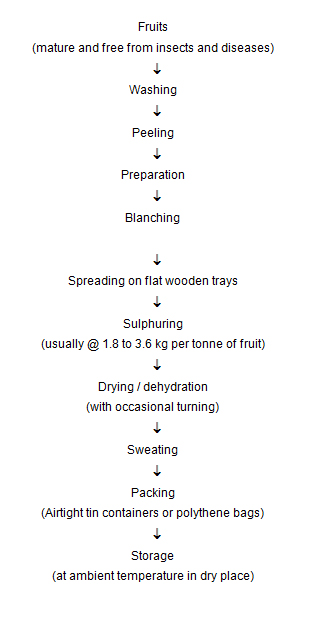
VI. PICKLE PRODUCTION
Top
The preservation of food in common salt or in vinegar is known as pickling. It is one of the most ancient methods of preserving fruits and vegetables. Pickles are good appetizers and add to the palatability of a meal. They stimulate the flow of gastric juice and thus help in digestion. At present, pickles are prepared with salt, vinegar, oil or with a mixture of salt, oil, spices and vinegar. |

 FLOWCHART FOR PROCESSING OF SQUASH
FLOWCHART FOR PROCESSING OF SQUASH




 A. JAM
A. JAM 


